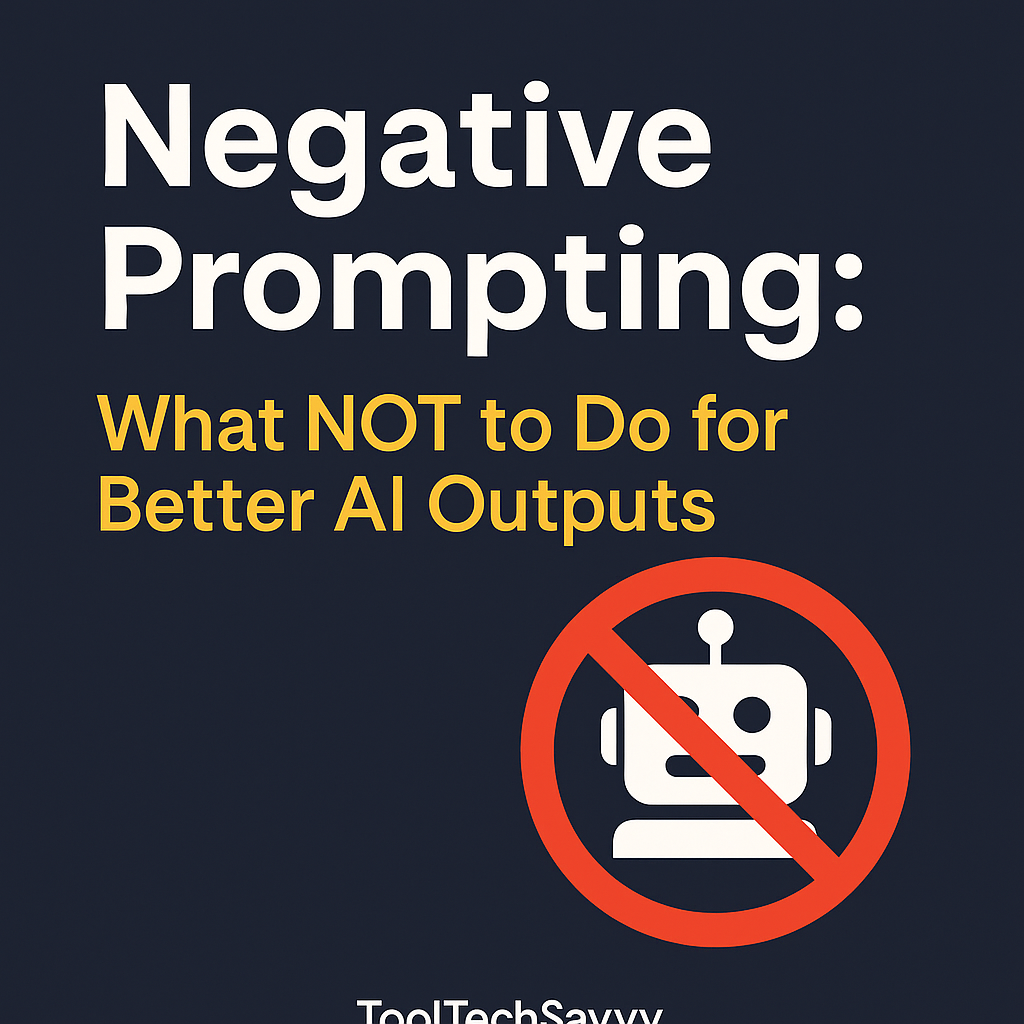When you’re trying to get precise results from AI models like ChatGPT or Midjourney, negative prompting can be your secret weapon—or your downfall. While most creators focus on what to include in a prompt, knowing what not to do is equally powerful.
In this post, we’ll break down how negative prompting works, common pitfalls, and how to refine your AI instructions for more reliable, creative, and consistent results.
Negative prompting is the art of telling AI models what to avoid generating. For instance, when you write:
“Write a professional email, but don’t use overly formal language.”
you’re using a negative constraint to shape the output. The goal is to filter out noise—unwanted tone, style, or content.
However, many users misuse negative prompts, leading to vague or contradictory outputs. Understanding this technique can dramatically improve the quality and focus of your AI-generated results.
Don’t Be Vague (But Don’t Overexplain Either)
The mistake: “Write something about marketing.”
Why it fails: AI models need direction, but there’s a sweet spot. Too vague and you get generic outputs. Too detailed and you constrain creativity unnecessarily.
Better approach: Provide clear boundaries with room to manoeuvre. “Write a 300-word marketing email for B2B SaaS companies about our new analytics feature” gives structure without micromanaging.
Don’t Ignore Output Format
The mistake: Asking for information without specifying how you want it delivered.
Why it fails: You might want bullet points but get paragraphs. You need a table but receive prose. The AI can’t read your mind about format preferences.
Better approach: Explicitly state your desired format upfront. “Create a comparison table” or “List 5 bullet points” or “Write in tweet format (280 characters max).”
Don’t Skip Examples When You Have Strong Preferences
The mistake: Expecting the AI to match your style or tone without showing examples.
Why it fails: Terms like “professional” or “casual” mean different things to different people. Without examples, you’re rolling the dice.
Better approach: Include 1-2 examples of the style, tone, or structure you want. “Write in a similar style to this…” is incredibly powerful. For more on this, check out proven ChatGPT techniques every advanced user should know.
Don’t Forget Context
The mistake: Jumping straight to your request without explaining the situation.
Why it fails: Context dramatically affects output quality. A sales email to enterprise clients differs vastly from one targeting freelancers.
Better approach: Front-load relevant context. “I’m pitching to CTOs at Fortune 500 companies who are currently using legacy systems…” shapes everything that follows.
Don’t Use Negative Instructions Exclusively
The mistake: “Don’t be boring. Don’t use jargon. Don’t make it too long.”
Why it fails: Telling the AI what not to do leaves infinite possibilities for what it should do. Negative constraints alone create confusion.
Better approach: Balance negative with positive instructions. “Don’t use jargon” becomes “Use plain language that a high school senior could understand.”
Don’t Ask for Multiple Unrelated Tasks Simultaneously
The mistake: “Write a blog post, create 5 social media captions, generate 3 email subject lines, and outline a video script.”
Why it fails: The AI splits attention across tasks, delivering mediocre results for all rather than excellent results for one.
Better approach: One task per prompt, or clearly separate related tasks. “First, write the blog post. Then I’ll ask for social media adaptations.” You can even build complex workflows with AI copilots and Zapier for multi-step processes.
Don’t Ignore Token Limits
The mistake: Asking for comprehensive outputs without considering length limitations.
Why it fails: Responses get cut off mid-sentence. Important information ends up truncated. You waste time on incomplete outputs.
Better approach: Break large requests into chunks. “Let’s start with the introduction section, then we’ll move to the methodology.” Learn more about token limits and how to fit more data into your LLM prompts.
Don’t Assume the AI Knows Your Domain Jargon
The mistake: Using industry-specific abbreviations or internal terminology without explanation.
Why it fails: Even advanced AI models can misinterpret specialized jargon or create plausible-sounding but incorrect explanations.
Better approach: Define acronyms and specialized terms on first use. “We use MEDDPICC (Metrics, Economic Buyer, Decision Criteria…)” prevents misunderstandings.
Don’t Accept First Drafts
The mistake: Taking the initial output as final without iteration.
Why it fails: First attempts are rarely optimal. The real power of AI comes from conversational refinement.
Better approach: Treat AI interaction as a dialogue. “Good start. Now make it more concise and add data points to support the main claims.” Prompt chaining can help you build better outputs through iteration.
Don’t Mix Tasks with Different Personas
The mistake: Asking for formal business analysis then casual blog content in the same conversation thread.
Why it fails: The AI maintains conversational context. Conflicting tones and purposes create inconsistent outputs.
Better approach: Start fresh conversations for different projects or explicitly instruct persona switches. “Now forget the formal tone and write as a friendly expert…”
Don’t Neglect Fact-Checking
The mistake: Trusting statistical claims, dates, or technical details without verification.
Why it fails: AI models can “hallucinate” plausible-sounding but incorrect information, especially with numbers and recent events.
Better approach: Verify factual claims, especially statistics, dates, and technical specifications. Use AI as a drafting tool, not a research endpoint. For current information, leverage AI tools you can start using today that require no tech skills.
Don’t Use AI for Tasks Requiring Current Information Without Search Capabilities
The mistake: Asking about recent events, current prices, or today’s news from models with knowledge cutoffs.
Why it fails: Training data has cutoff dates. Models can’t access information beyond their training period without search capabilities.
Better approach: Use AI tools with web search features for current information, or manually provide recent data as context. Tools like Perplexity AI specialize in current information retrieval.
The Bottom Line
Negative prompting isn’t about avoiding AI—it’s about avoiding the mistakes that waste your time and produce mediocre results. The best prompts combine what to do with what not to do, creating clear guardrails for optimal outputs.
Start with these anti-patterns in mind, and you’ll immediately see improved results. Better yet, you’ll waste less time on iterations and corrections.
Want to dive deeper into AI productivity? Explore advanced prompt patterns for better AI outputs.



